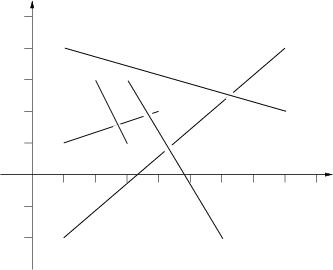题目链接:http://poj.org/problem?id=2653
Time Limit: 3000MS Memory Limit: 65536K
Description
Stan has n sticks of various length. He throws them one at a time on the floor in a random way. After finishing throwing, Stan tries to find the top sticks, that is these sticks such that there is no stick on top of them. Stan has noticed that the last thrown stick is always on top but he wants to know all the sticks that are on top. Stan sticks are very, very thin such that their thickness can be neglected.
Input
Input consists of a number of cases. The data for each case start with 1 <= n <= 100000, the number of sticks for this case. The following n lines contain four numbers each, these numbers are the planar coordinates of the endpoints of one stick. The sticks are listed in the order in which Stan has thrown them. You may assume that there are no more than 1000 top sticks. The input is ended by the case with n=0. This case should not be processed.
Output
For each input case, print one line of output listing the top sticks in the format given in the sample. The top sticks should be listed in order in which they were thrown.
The picture to the right below illustrates the first case from input.
The picture to the right below illustrates the first case from input.

Sample Input
5 1 1 4 2 2 3 3 1 1 -2.0 8 4 1 4 8 2 3 3 6 -2.0 3 0 0 1 1 1 0 2 1 2 0 3 1 0
Sample Output
Top sticks: 2, 4, 5. Top sticks: 1, 2, 3.
Hint
Huge input,scanf is recommended.
题意:
给出n根细木棍的坐标,每次按顺序放到指定坐标位置,这样会导致一些后放的木棍压倒前面的木棍;
求最后那些木棍没有被压住。
题解:
刚开始我是每输入第i跟木棍,就遍历1 ~ i-1的木棍,看看他们有没有被压住,但这样最后TLE了;
看Dis里说,先全部输入,然后枚举,对第i根木棍,遍历i+1 ~ n的木棍,一旦出现压住i的,就标记并且跳出;
明明感觉这样不T很不科学,但就是AC了……奇怪……
AC代码:

#include<cstdio> #include<cmath> #include<iostream> using namespace std; const double eps = 1e-6; struct Point{ double x,y; Point(double tx=0,double ty=0):x(tx),y(ty){} }; typedef Point Vctor; //向量的加减乘除 Vctor operator + (Vctor A,Vctor B){return Vctor(A.x+B.x,A.y+B.y);} Vctor operator - (Point A,Point B){return Vctor(A.x-B.x,A.y-B.y);} Vctor operator * (Vctor A,double p){return Vctor(A.x*p,A.y*p);} Vctor operator / (Vctor A,double p){return Vctor(A.x/p,A.y/p);} int dcmp(double x) { if(fabs(x)<eps) return 0; else return (x<0)?(-1):(1); } bool operator == (Point A,Point B){return dcmp(A.x-B.x)==0 && dcmp(A.y-B.y)==0;} double Cross(Vctor A,Vctor B){return A.x*B.y-A.y*B.x;} //判断线段是否规范相交 bool SegmentProperIntersection(Point a1,Point a2,Point b1,Point b2) { double c1 = Cross(a2 - a1,b1 - a1), c2 = Cross(a2 - a1,b2 - a1), c3 = Cross(b2 - b1,a1 - b1), c4 = Cross(b2 - b1,a2 - b1); return dcmp(c1)*dcmp(c2)<0 && dcmp(c3)*dcmp(c4)<0; } int n; struct Seg{ Point a,b; bool pressed; }seg[100005]; int main() { while(scanf("%d",&n) && n!=0) { for(int i=1;i<=n;i++) { scanf("%lf%lf%lf%lf",&seg[i].a.x,&seg[i].a.y,&seg[i].b.x,&seg[i].b.y); seg[i].pressed=0; } for(int i=1;i<=n;i++) { for(int j=i+1;j<=n;j++) { if(SegmentProperIntersection(seg[i].a,seg[i].b,seg[j].a,seg[j].b)) { seg[i].pressed=1; break; } } } printf("Top sticks: "); for(int i=1,cnt=1;i<=n;i++) { if(seg[i].pressed) continue; if(cnt!=1) printf(", "); printf("%d",i); cnt++; } printf(". "); } }
